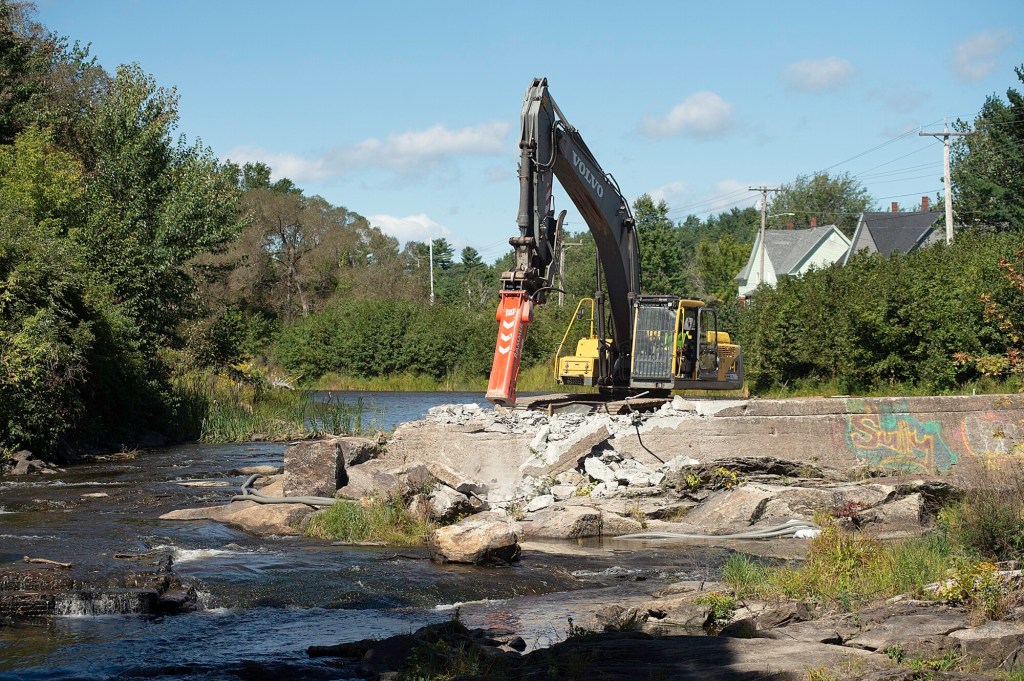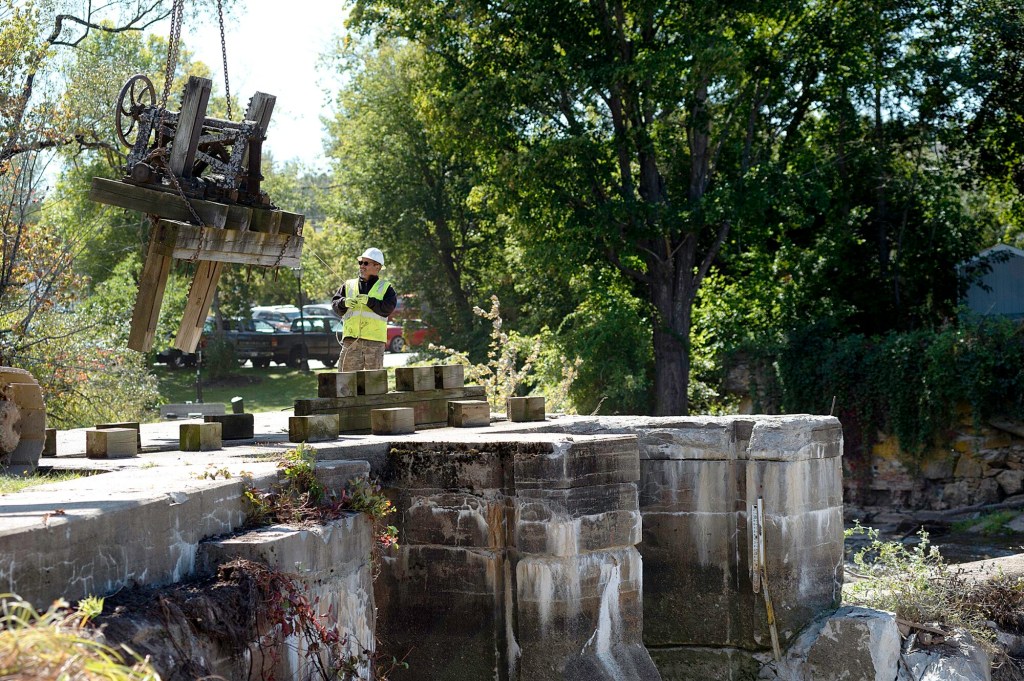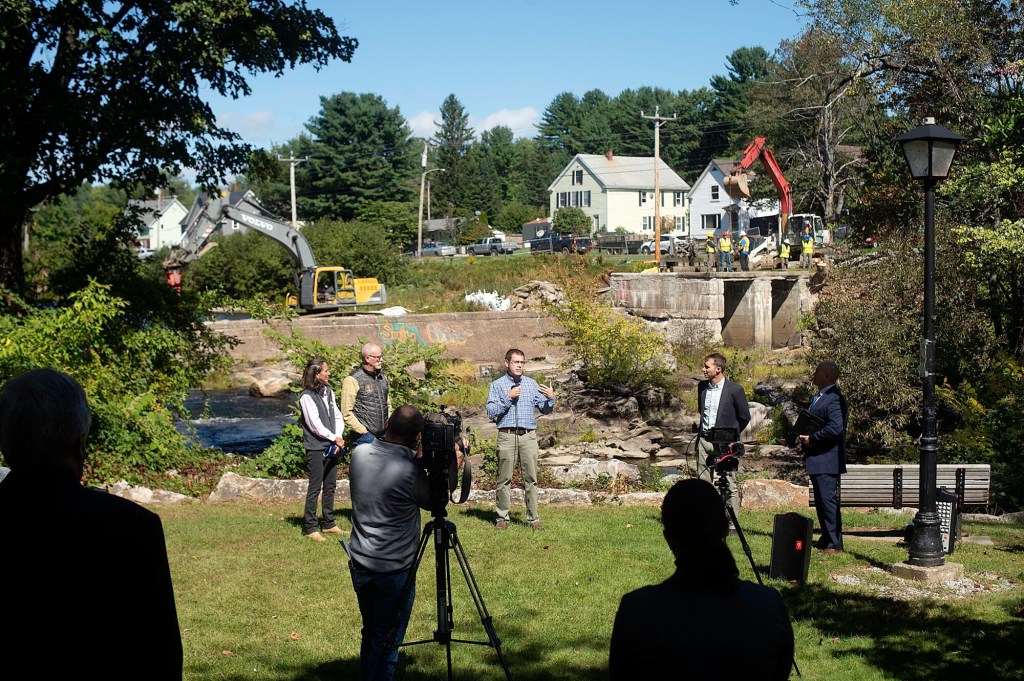LISBON — Local conservation organizations are making strides on a multi-year plan to restore the Sabattus River and enable upstream fish passage for the first time in at least two hundred years.
Conservationists are aiming to either remove or construct fish ladders over the five remaining dams on the river in the next several years, opening access to 75 miles of river and stream habitat for migrating fish.
On Thursday, officials gathered in Lisbon on the banks of the Sabattus River to celebrate the removal of Upper Town Dam, located just upstream of Webster Road. It’s the second dam to be removed from the river in recent years.
In 2019, the Mill Street dam in Lisbon was removed from the Sabattus River, along with mercury-contaminated soil. The dam was located about a mile downstream of the Upper Town Dam.
Officials say the removal of the Upper Town Dam will not only provide environmental benefits, but will also lower flood insurance costs for riverside properties, reduce safety hazards and create jobs.
In 2012, the dam failed during a prolonged rainstorm. There does not appear to have been any injuries resulting from the breach, which was never repaired.

Employees of Linkel Environmental Construction remove one of two iron gate works from the dam Thursday on the Sabattus River in Lisbon. Both gate works were removed and will be kept by the town of Lisbon to be put on display at a later date. Daryn Slover/Sun Journal
“The incredible work beginning here on the Sabattus River is representative of investments being made all across the country to safeguard our rivers and ensure that future generations have clean air, drinkable water, fertile soil, and an overall quality of life that is currently threatened by the worsening climate crisis,” said Winnie Stachelberg, U.S. Department of the Interior senior advisor and infrastructure coordinator.
Conservationists estimate that restoring fish passage to the Sabattus River system could add 500,000 self-sustaining adult alewives to the Androscoggin River watershed each year.
John Burrows, executive director of U.S. operations for the Atlantic Salmon Federation, already estimates 10-20 thousand alewives travel from the Atlantic ocean to the Sabattus River each year. However, due to barriers, the fish are unable to travel up the river to reach spawning habitat.
“They’re sitting there waiting now,” Burrows said.
In additional to alewives, conservationists say improved fish passage will benefit blueback herring, American shad, federally endangered Atlantic salmon, and American eel, which need to migrate between fresh and saltwater to complete their lifecycles. Bald eagles, loons and striped bass will also see a boost from the improved ecosystem.
The $650,000 project, which also includes a second dam removal in Sabattus next year, was funded in part by the $1 trillion bipartisan infrastructure bill passed by Congress last November.

Interim Lisbon Town Manager and Police Chief Ryan McGee speaks Thursday prior to work being done to remove remnants of two dams on the Sabattus River in Lisbon. Daryn Slover/Sun Journal
The Sabattus River restoration project was awarded $350,000 from the program; the other $300,000 was funded by the Atlantic Salmon Federation, Maine Department of Marine Resources, the National Fish and Wildlife Foundation National Coastal Resilience Fund, and other conservation organizations.
The federal infrastructure bill has $200 million earmarked to improve fish passage across the country over the next five years. In the first round of funding, the Sabattus River project was the only one to receive funding in Maine and one of just two in New England.
“For all of these reasons, the Sabattus River project is a prime example of what this law was created to do: address infrastructure needs and climate change by reconnecting rivers and streams that are the lifeblood of communities and that are vital habitat for wildlife,” Stachelberg said.
In some cases, removing dams on the Sabattus River is not feasible. The former Farwell Mill dam located directly downstream of Webster Road will likely remain intact, and a fish ladder built to facilitate fish migration, Burrows said.
The dam, which is built into the mill, would require extensive renovations to the building, he said. And because the river channel was moved to a steeper grade location to better power the mill, even if the dam were to be removed, a fish ladder would still need to be added.
Built in 1808, the Upper Town Dam was constructed to power what may have been the first woolen textile mill in the state, according to Clark. With the mill long gone, the dam no longer serves the same purpose as it once did.
Two iron gate works recovered from the dam will be preserved by the town to memorialize the mill, according to Ross Cunningham, director of economic and community development in Lisbon.
Send questions/comments to the editors.









